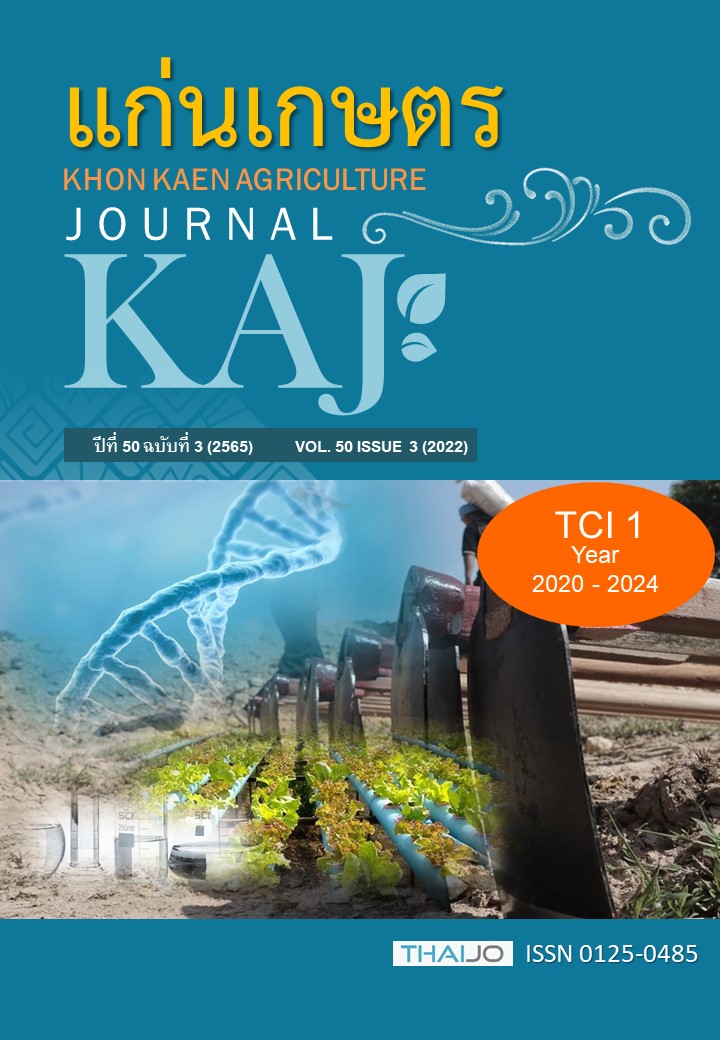การศึกษาเมทาจีโนมิกส์ของเชื้อราและประสิทธิภาพในการผลิตสารเมแทบอไลต์ทุติยภูมิ ของเชื้อราที่คัดแยกได้จากลำไส้ไส้เดือนดิน Perionyx sp. 1
Main Article Content
บทคัดย่อ
งานวิจัยนี้มีวัตถุประสงค์เพื่อศึกษาชนิดของเชื้อราในลำไส้ของไส้เดือนดิน Perionyx sp. 1 และศึกษาประสิทธิภาพการผลิตสารเมแทบอไลต์ทุติยภูมิ (IAA, GA และอนุพันธุ์ไฮโดรซาเมตไซเดอร์โรฟอร์ ) ขอเชื้อราที่คัดแยกได้ผลการศึกษาเมทาจีโนมิกส์ พบความแตกต่างของลำดับนิวคลีโทด์ ITS1 ของเชื้อรา สามารถจัดจำแนกได้ 3 ไฟลัม 8 คลาส 32 จีนัส 49 เมื่อคัดแยกเชื้อราบนอาหาร PDA และ YMA สามารถคัดแยกเชื้อราที่แตกต่างกันได้ 11 ไอโซเลต จากการตรวจสอบยีนบริเวณ ITS1 สามารถระบุชนิดของเชื้อราได้เป็น Talaromyces wortmannii (YL1), Chaetomium globosum (YL2), T. indioticus (YL3), T. angelicus (RL1), Trichoderma sp. (RL2), Aspergillus niger (RL3), Penicillium citrinum (Pe1), A. fumigatus (Pe2), A. flavus (Pe3), Humicola sp. (Pe5) และ Fusarium sp. (Pe6) จากการทดสอบความสามารถในการผลิตสารเมแทบอไลต์ทุติยภูมิทั้งสามชนิด พบว่า เชื้อราที่เลี้ยงในอาหารเลี้ยงเชื้อ PDBt ที่เติม 0.4% L-tryptophan สามารถผลิต IAA เฉลี่ย 36.58 µg/ml ส่วนอาหารที่ไม่เติม L-tryptophan ผลิต IAA เฉลี่ย 23.55 µg/ml ซึ่งจะเห็นได้ว่าเชื้อรามีแนวโน้มการผลิตฮอร์โมน GA ที่สัมพันธ์กับฮอร์โมน IAA ส่วนสารอนุพันธ์ไฮโดรซาเมตพบว่าเชื้อราผลิตได้เฉลี่ย 180.993 µg/ml โดยเชื้อราไอโซเลต RL3 (Aspergillus niger) มีประสิทธิภาพสูงสุด สามารถผลิตได้ปริมาณ 1,629.90 ± 0.0128 µg/ml และน้ำเลี้ยงเชื้อรา RL3 สามารถกระตุ้นการเจริญเติบโตของถั่วเขียวได้ดีที่สุดเมื่อเติมสารละลายเหล็ก 1:103 งานวิจัยนี้ชี้ให้เห็นถึงประสิทธิภาพของเชื้อราที่คัดแยกได้จากลำไส้ของไส้เดือนดินต่อการผลิตสารส่งเสริมการเจริญเติบโตของพืชจึงน่าจะสามารถนามาใช้ประโยชน์ในการ ส่งเสริมการเจริญเติบโตของพืชได้
Article Details

อนุญาตภายใต้เงื่อนไข Creative Commons Attribution-NonCommercial-NoDerivatives 4.0 International License.
เอกสารอ้างอิง
Barlier, I., M. Kowalczyk, A. Marchant, K. Ljung, R. Bhalerao, M. Bennett, G. Sandberg, and C. Bellini. 2000. The SUR2 gene gene of Arabidopsis thaliana encodes the cytochrome P450 CYP83B1, a modulator of auxin homeostasis. Proceedings of the National Academy of Science of the United States of America. 97: 14819-14824.
Bilkey, I.S., S. Karakoc, and N. Aksoz. 2010. Indole-3-acetic and gibberellic acid production in Aspergillus niger. Turkish Journal of Biology. 34: 313-318.
Caron, M., C.L. Patten, and S. Ghosh. 1995. Effects of plant growth promoting rhizobacteria Pseudomonas putida GR-122 on the physiology of Canolla roots. Proceedings of Growth Regulation Society of America 2nd edition. Society press, Madison, Wisconsin.
Chowdhury, A., A. K. Hazra, S. Mahajan, and J. Choudhury. 2007. Microbial Community of Earthworm (Perionyx excavatus Perrier) gut, cast and adjacent soil in two different field of west Bengal. Records of the Zoological Survey of India. 107(4): 101-113.
Hasan, H.A.H. 2002. Gibberellin and auxin production by plant root fungi and their biosynthesis under salinity-calcium interaction. Rostlinna Vyroba. 3: 101-106.
Haydon, A.H., W.B. Davis. J.E.L. Arceneaux, and B.R. Byers. 1973. Hydroxamate recognition during iron transport from hydroxamate ironchelates. Jornal of Bacteriology. 115: 912-918.
Hilbert, M., L.M. Voll, Y. Ding, J. Hofmann, M. Sharma, and A. Zuccaro. 2012. Indole derivative production by the root endophyte Piriformospora indica is not required for growth promotion but biotrophic colonization of barley roots. New Phytologist. 196: 520-534.
Holbrook, A.A., W.J. Edge. And F. Bailey. 1961. Spectrophotometric method for determination of gibberellic acid. American Chemical Society. 28: 159-167.
Lynch, J.M., Vaughan, D. and Malcom, R.E. 1985. Origin, Nature and Biological Activity of Aliphatic Substances and Growth Hormones Found in Soil Organic Matter and Biological Activity. 16: 151-174.
Mano, Y., and K. Nemoto. 2012. The pathway of auxin biosynthesis in plants. Journal of Experimental Botany 63: 2853-2872.
Mikkelsen, M.D., C.H. Hansen, U. Wittstock, and B.A. Halkier. 2000. Cytochrome P450 CYP79B2 from Arabidopsis catalyzes the conversion of tryptophan to indole-3-acetaldoxine, a precursor of indole glucosinolates and indole-3-acetic acid, Journal of Biological Chemistry. 275: 33712-33717.
Nafisi, M., S. Goregaoker, C.J. Botanga, E. Glawischnig, C.E. Olsen, B.A. Halkier, and J. Glazebrook. 2007. Arabidopsis cytochrome P450 monooxygenase 71A13 catalyzes the conversion of indole-3-acetaldoxine in camelexin. Plant Cell. 19: 2039-2052.
Srivastava, L.M.2002.Plant growth and development. Hormones and the Environment. Academic Press. New York.
Suleerak, A., T. Arnat, N. Piyanuch, and R. Pattaraporn. 2016. The Potential of Bacteria Isolated from Earthworm Intestines, Vermicompost and Liquid Vermicompost to Produce Indole- 3- acetic acid (IAA). Journal of Agricultural Technology. 12(2): 229-239
Taiz, L. and E. Zeiger. 2010. Plant physiology. The Benjamin/Cummings Publishing Co. Inc., California.
Tancho, A. 2013. Natural Farming. Chiang Mai: Trio Advertising and Media Co., Ltd.
Tsavkelova, E.A., T.A. Cherdyntseva, S.G. Botin, And A.l. Netrusov. 2007. Bacteria associated with orchid roots and microbial production of auxin. Microbiological Research. 162: 69-76.


